SalesLoft has long been a dominant force in the sales engagement space, enabling teams to structure and execute outreach at scale. However, a one-size-fits-all solution rarely fits everyone perfectly. High-performing sales and marketing teams are increasingly finding that specific needs, such as advanced AI personalization, strict deliverability controls, or more accessible pricing, are better met by specialized platforms. The search for effective SalesLoft alternatives is no longer just about cutting costs; it's a strategic move to find a tool that aligns precisely with a team's unique go-to-market motion. The drive to enhance efficiency and streamline sales processes is a primary reason teams seek these alternatives, embodying the core principles of workflow automation.
This comprehensive guide is designed to cut through the noise. We will analyze 12 of the best platforms on the market, from all-in-one giants to nimble, AI-focused innovators like PlusVibe. Each review provides a detailed breakdown covering:
- Key Features: A close look at cadence builders, AI capabilities, and integrations.
- Ideal Use Cases: Who the platform is truly built for.
- Pricing: A clear overview of available tiers.
- Pros and Cons: An honest assessment of strengths and limitations.
We provide screenshots, direct links, and practical insights to help you make a confident decision. Whether you're a small business owner, a lead generation agency, or a sales leader at a growing enterprise, this resource will help you identify the right sales engagement platform to replace or augment your existing stack and achieve better results.
1. PlusVibe
PlusVibe emerges as a top choice and one of the most compelling Salesloft alternatives, particularly for teams prioritizing deliverability and AI-driven efficiency in their cold outreach. It’s an AI-first platform built from the ground up to solve the core challenges of modern outbound: getting emails into the primary inbox and making them feel personalized at scale. Unlike all-in-one CRMs that treat outreach as just one feature, PlusVibe's entire architecture is dedicated to maximizing inbox placement and automating high-quality engagement.
The platform's standout strength is its obsessive focus on deliverability. It integrates a private email warm-up network, algorithmic IP rotation, and automatic SPF, DKIM, and DMARC configuration. This comprehensive, built-in system works in the background to build and protect sender reputation, a critical factor many other platforms treat as an add-on or a manual task. This technical foundation is what enables its powerful AI features to perform effectively.
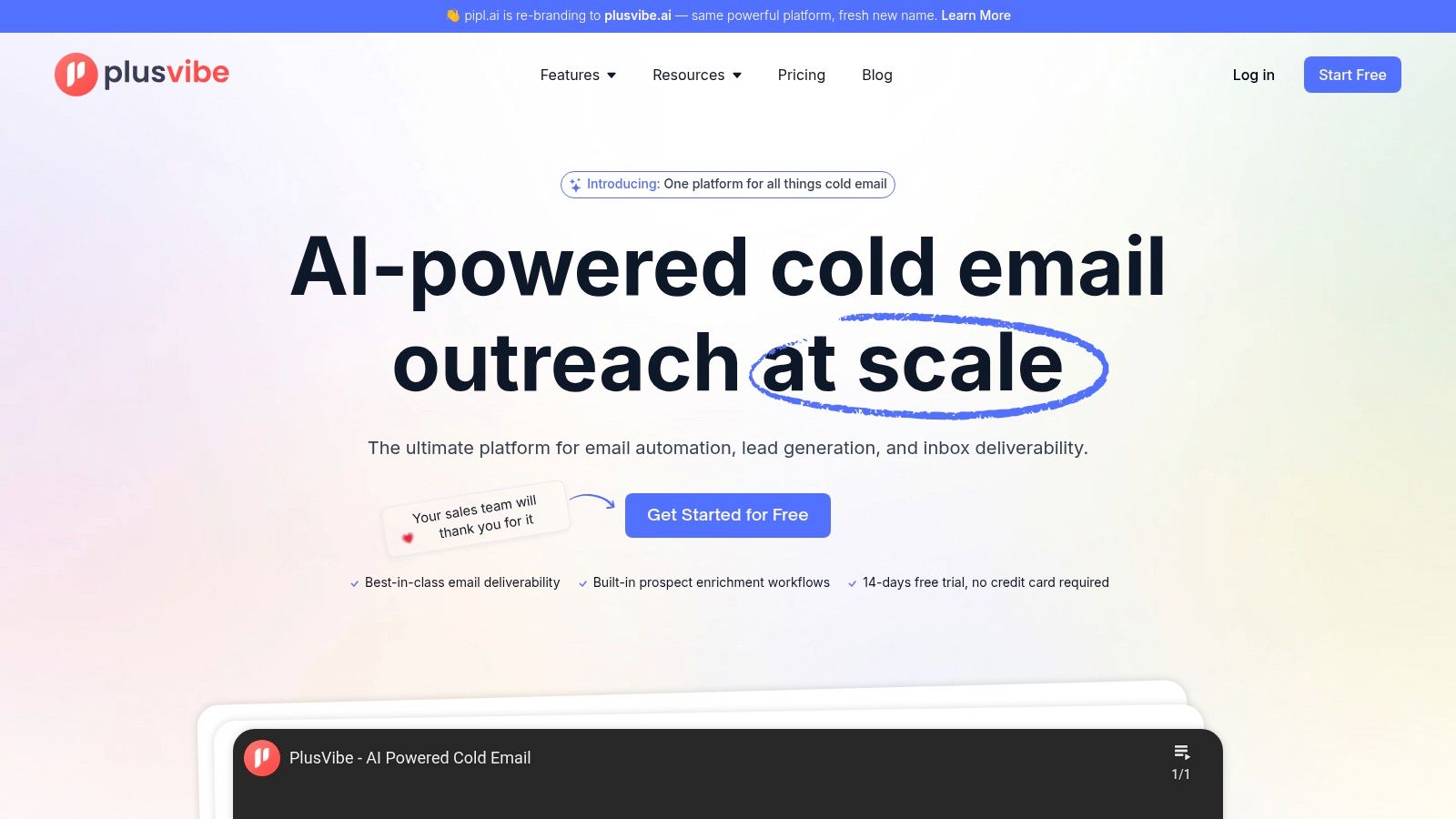
Key Features & Use Cases
PlusVibe consolidates what would typically require 4-5 different tools into a single, unified workflow.
- Deliverability-First Architecture: Its private warm-up pools, IP rotation, and automated DNS setup are designed to achieve and maintain high inbox placement rates, with the platform reporting a ~99.8% warm-up inbox rate. This is ideal for GTM teams that cannot afford to have their campaigns land in spam.
- AI-Powered Personalization & Automation: The platform leverages AI to generate hyper-relevant first lines and entire sequences, adapting messages based on prospect data. Its AI Reply Agent can detect intent (e.g., "interested," "not now") and automate the appropriate follow-up, saving sales reps significant time.
- All-in-One Outbound Stack: PlusVibe includes a built-in lead scraper, real-time email validation, and data enrichment from over 80 sources. A lead generation agency, for example, could use this to build a targeted list, enrich it with relevant data, and launch a validated campaign from one dashboard.
- Proven ROI & Strong Social Proof: With customer-reported reply rates of 4-5% at scale and case studies showing a 58% positive response rate, the platform demonstrates tangible results. Agencies also report significant cost savings (up to 63%) by consolidating their tech stack into PlusVibe.
Pricing
PlusVibe offers a 14-day free trial without requiring a credit card. While detailed pricing tiers are not publicly listed, the model appears to be usage-based, with some actions like advanced validation consuming credits. This structure allows businesses to pay for what they use, but prospective users should connect with their team to understand the total cost based on their expected volume and feature needs.
Pros and Cons
Pros:
- Unmatched deliverability controls with a private warm-up pool and auto-configured DNS.
- Powerful AI personalization and reply automation scales relevant outreach.
- Integrated tooling (scraping, enrichment, validation) reduces stack complexity and cost.
- Strong community and support including a Slack channel and 1:1 onboarding.
Cons:
- Pricing transparency requires a direct inquiry for a clear, long-term cost estimate.
- Results depend on user inputs; while the tech is powerful, success still relies on good list quality and messaging strategy.
Bottom Line: PlusVibe is an exceptional choice for teams seeking a robust, deliverability-focused alternative to SalesLoft. It's particularly well-suited for agencies, small businesses, and enterprise GTM teams that need to scale high-quality outreach without the complexity and cost of managing multiple separate tools. For a deeper dive into its capabilities, you can learn more about PlusVibe's cold email automation on their website.
2. Outreach
Outreach is a powerful sales execution platform designed for mid-market and enterprise teams seeking an all-in-one alternative to SalesLoft. It expands beyond basic sales engagement, incorporating AI-assisted workflows for prospecting, deal management, conversation intelligence, and forecasting. This comprehensive approach makes it a robust command center for large, complex sales organizations that require deep functionality and strict governance.
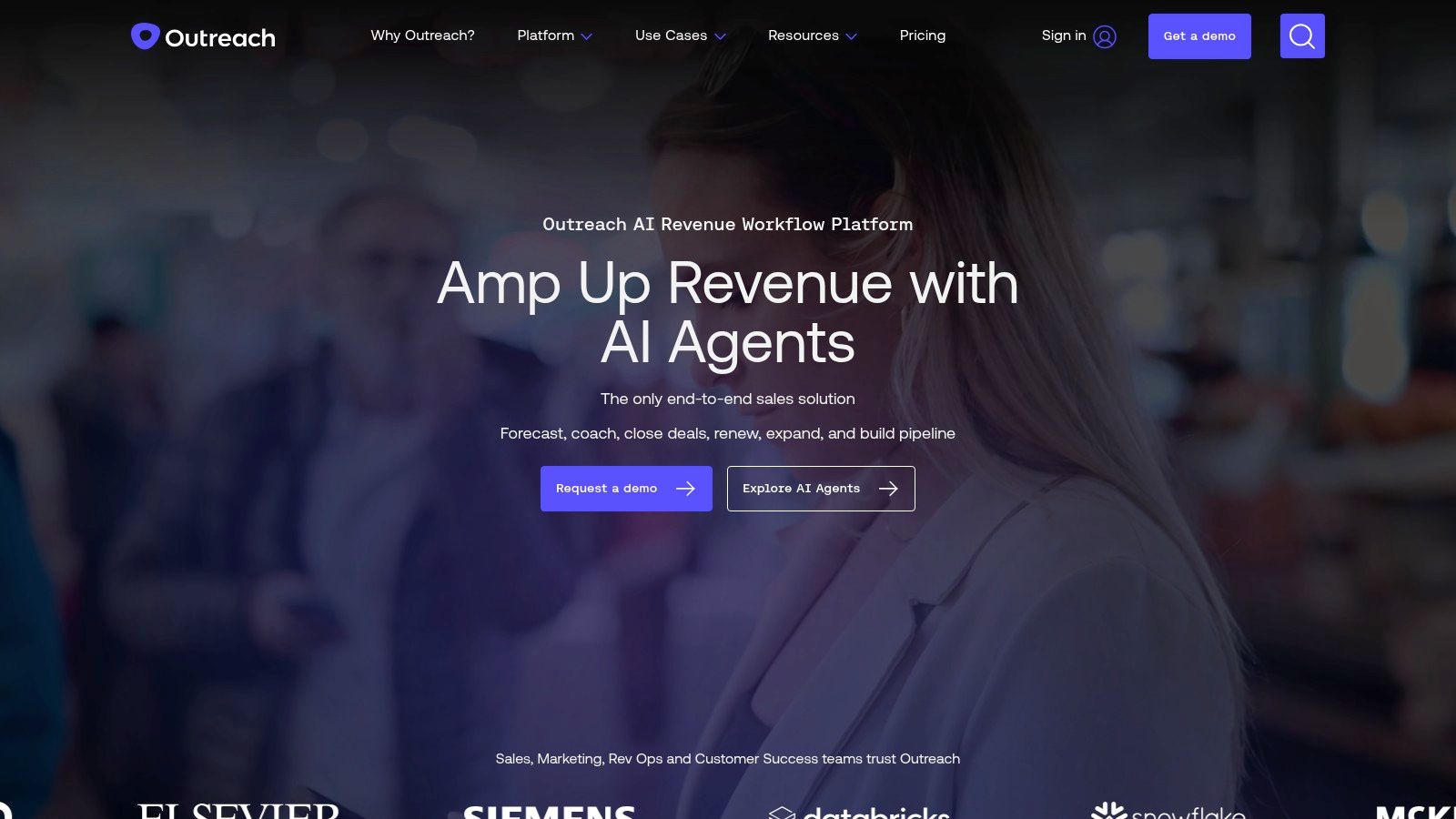
Unlike tools focused solely on sequencing, Outreach provides an integrated system to manage the entire sales cycle. Its AI-driven "Kaia" (Knowledge AI Assistant) offers real-time coaching during calls, and its deal inspection features give managers unparalleled visibility into pipeline health. This makes it ideal for teams needing to standardize processes, improve rep performance, and achieve predictable revenue growth at scale. If you are comparing these two giants, our detailed analysis on Outreach vs. Salesloft offers deeper insights.
Key Features & Use Cases
- AI-Assisted Cadences: Guides reps on the next-best action to take with prospects, optimizing for engagement.
- Conversation Intelligence: Analyzes sales calls to provide real-time coaching, identify key moments, and surface team-wide trends.
- Deal Management & Forecasting: Provides tools for pipeline inspection and more accurate revenue prediction.
- Robust Integrations: Features over 90 native integrations and an extensive API for custom connections.
Pros & Cons
- Pro: Offers extensive functionality beyond just sequencing, including coaching and forecasting.
- Pro: Strong governance and security features are ideal for enterprise-level organizations.
- Con: Pricing is quote-based and generally higher, reflecting its enterprise focus.
- Con: Implementation and user enablement require a significant investment of time and resources compared to simpler tools.
Who is Outreach for?
Outreach is best suited for established mid-market and enterprise sales teams that need a unified platform to manage complex sales cycles. It's an excellent choice for organizations prioritizing data-driven coaching, pipeline visibility, and process standardization over pure outbound volume. While a powerful platform, teams focused primarily on email deliverability and AI personalization might find more specialized tools like PlusVibe better address those specific needs.
3. Salesforce Sales Engagement (Sales Cloud add-on)
For organizations deeply embedded in the Salesforce ecosystem, Salesforce Sales Engagement (formerly High Velocity Sales) presents a compelling and native alternative to SalesLoft. As an add-on to Sales Cloud, it allows teams to build and execute sales cadences directly within their CRM, eliminating the need for complex data syncing and providing a single source of truth. This tight integration ensures seamless workflows and robust data governance, making it a natural choice for companies prioritizing a unified tech stack.
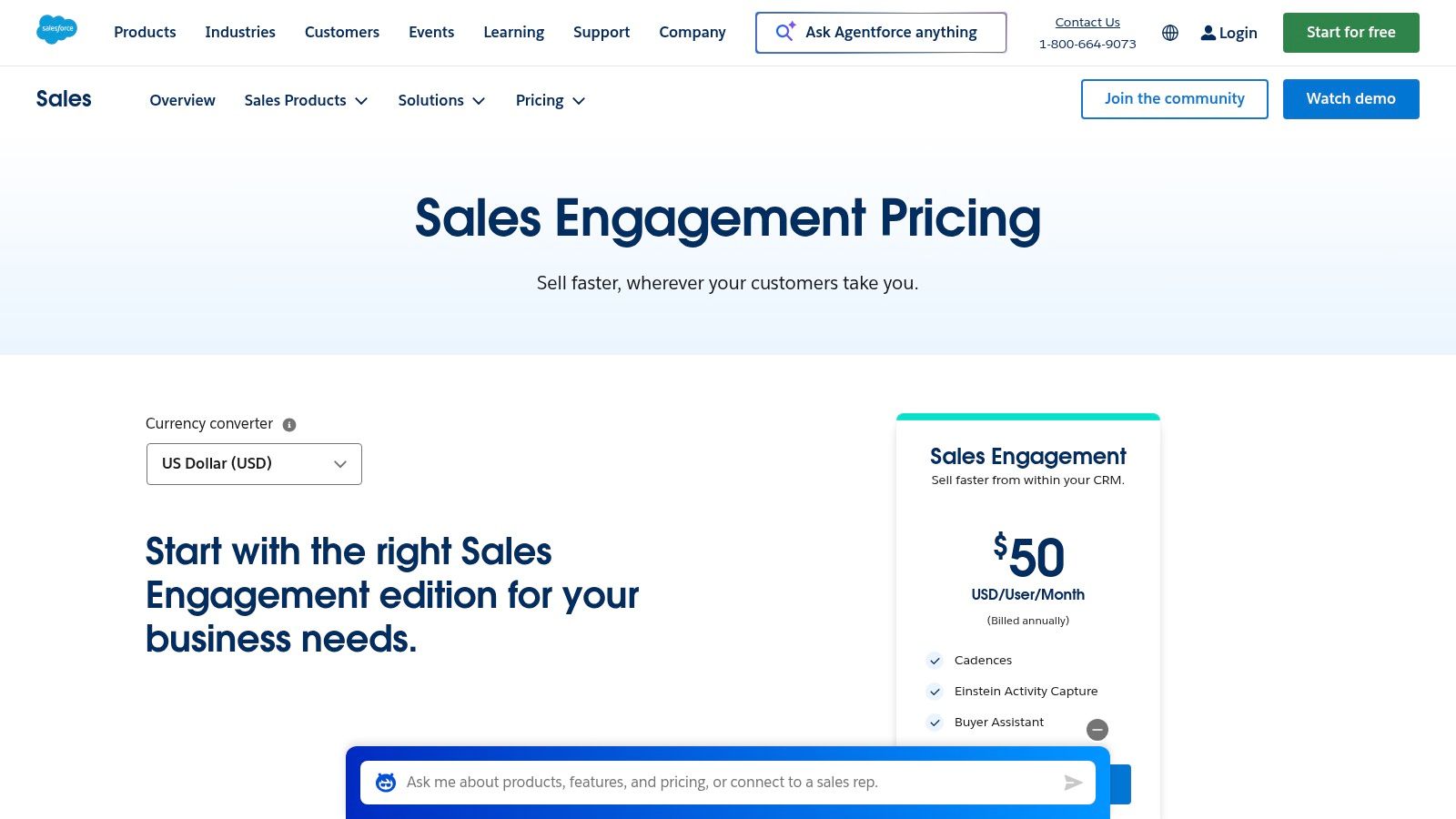
The platform leverages Salesforce’s own AI, Einstein, to provide email insights and activity capture, helping reps prioritize their efforts. Instead of operating a separate engagement tool, reps work from a unified "Work Queue" inside Salesforce, streamlining their day-to-day tasks. This approach is ideal for sales teams that live and breathe Salesforce and want to add structured outreach capabilities without introducing another third-party application.
Key Features & Use Cases
- Native Sales Cadences: Build multi-step, multi-channel outreach sequences directly on lead and contact records.
- Unified Work Queue: Consolidates all sales tasks (calls, emails, custom steps) into a single prioritized list for reps.
- Einstein Activity Capture: Automatically logs emails and events to the correct Salesforce records, reducing manual data entry.
- Conversation Intelligence: Provides call analysis and insights to improve coaching and rep performance within the Salesforce UI.
Pros & Cons
- Pro: Fully native to Salesforce, offering a single UI, data model, and streamlined governance.
- Pro: Predictable add-on pricing for existing Salesforce customers simplifies budgeting.
- Con: It is best suited for organizations already standardized on the Salesforce platform.
- Con: Feature depth for highly specialized outreach, like advanced AI personalization and email warming, may trail dedicated tools.
Who is Salesforce Sales Engagement for?
Salesforce Sales Engagement is the best option for existing Salesforce customers who want to add structured engagement functionality without leaving their CRM. It's perfect for sales leaders who prioritize data integrity, ease of administration, and a unified user experience. However, teams requiring more advanced AI personalization, deliverability controls, and email warming capabilities might find a more specialized solution like PlusVibe.ai better meets their specific outbound needs.
4. HubSpot Sales Hub
HubSpot Sales Hub is a comprehensive sales engagement platform built directly on top of its world-class CRM. It's an ideal SalesLoft alternative for teams that prioritize an all-in-one RevOps stack, combining marketing, sales, and service tools into a single, unified system. This integrated approach simplifies administration, streamlines data flow, and provides a seamless user experience for growing teams that value speed and ease of use.
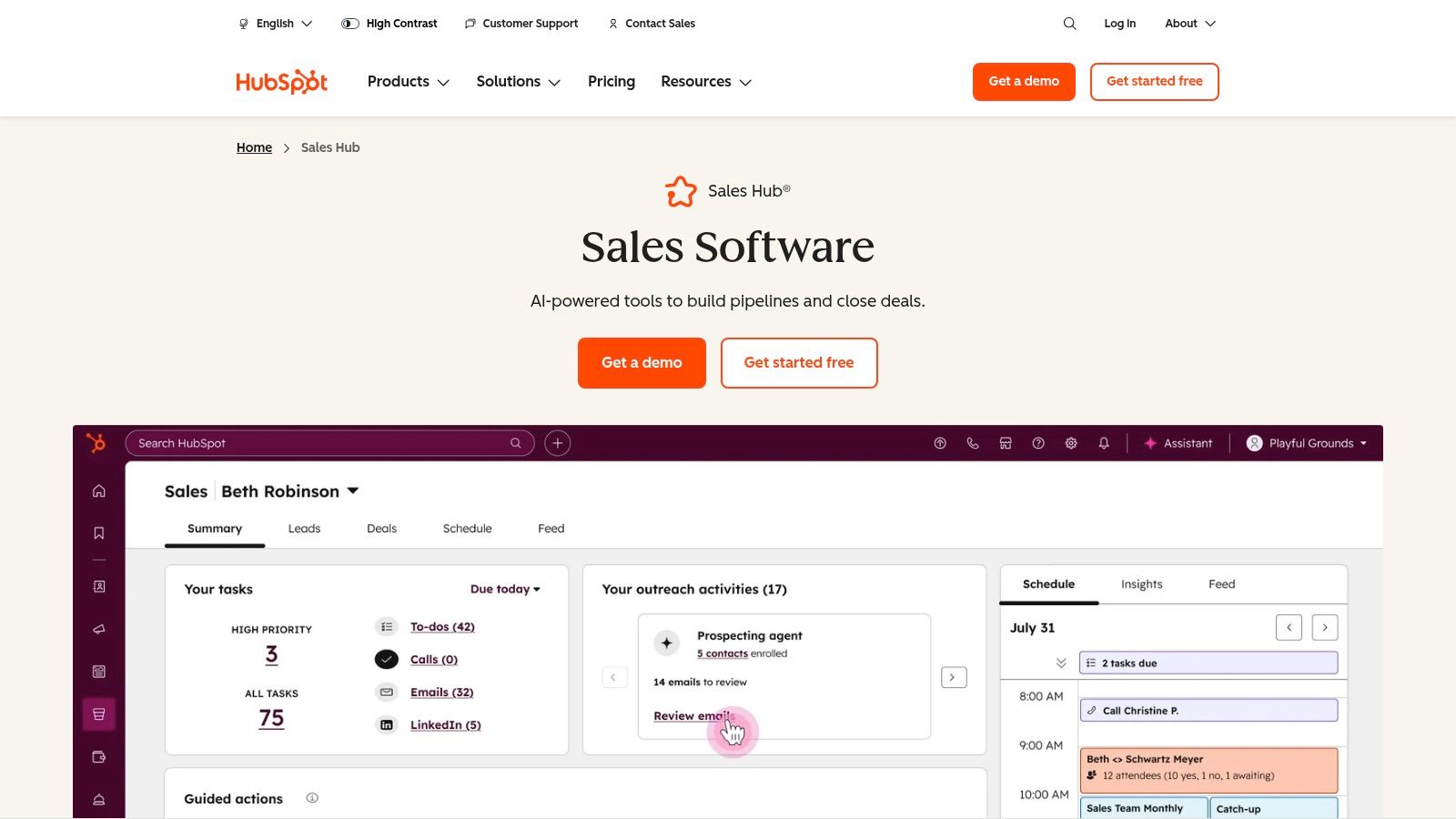
Unlike standalone sales engagement tools, HubSpot's strength lies in its ecosystem. Sales sequences, email templates, and call tracking are native functions, eliminating the need for complex syncs. The platform is designed for scalability, offering free tools to start and powerful enterprise-grade features as you grow. For those leveraging its robust CRM, our guide on HubSpot integrations can help maximize its potential.
Key Features & Use Cases
- Email Sequences & Templates: Automate follow-ups and build personalized outreach cadences directly within the CRM.
- Built-in Calling & Conversation Intelligence: Record, transcribe, and analyze sales calls to improve rep coaching (available on higher tiers).
- Forecasting & Custom Reporting: Create detailed sales reports and forecasts using live CRM data for a single source of truth.
- Deep HubSpot Ecosystem: Natively connects with Marketing Hub and Service Hub for a complete view of the customer journey.
Pros & Cons
- Pro: Extremely fast setup and an intuitive user experience reduce the learning curve.
- Pro: Offers powerful free tools and scales effectively from small businesses to enterprise teams.
- Con: Higher-tier plans often come with mandatory onboarding fees, increasing the initial investment.
- Con: Advanced governance and permission controls may require upgrading to the expensive Enterprise plan.
Who is HubSpot Sales Hub for?
HubSpot Sales Hub is best suited for SMBs and mid-market companies already using or planning to adopt the HubSpot CRM. It's an excellent choice for teams that want an integrated, easy-to-manage platform for their entire revenue operations. While it offers strong all-in-one functionality, teams focused on advanced AI personalization and maximizing email deliverability may find a specialized tool like PlusVibe provides more targeted capabilities.
5. Apollo.io (Sales Engagement)
Apollo.io stands out as a unique SalesLoft alternative by bundling a massive B2B contact database with a full-featured sales engagement platform. This all-in-one approach appeals to startups and sales teams looking to consolidate their tech stack and streamline prospecting and outreach workflows. By combining data enrichment, sequencing, an AI-powered dialer, and personalization tools under one subscription, it provides significant value for teams that need both lead sourcing and engagement capabilities.
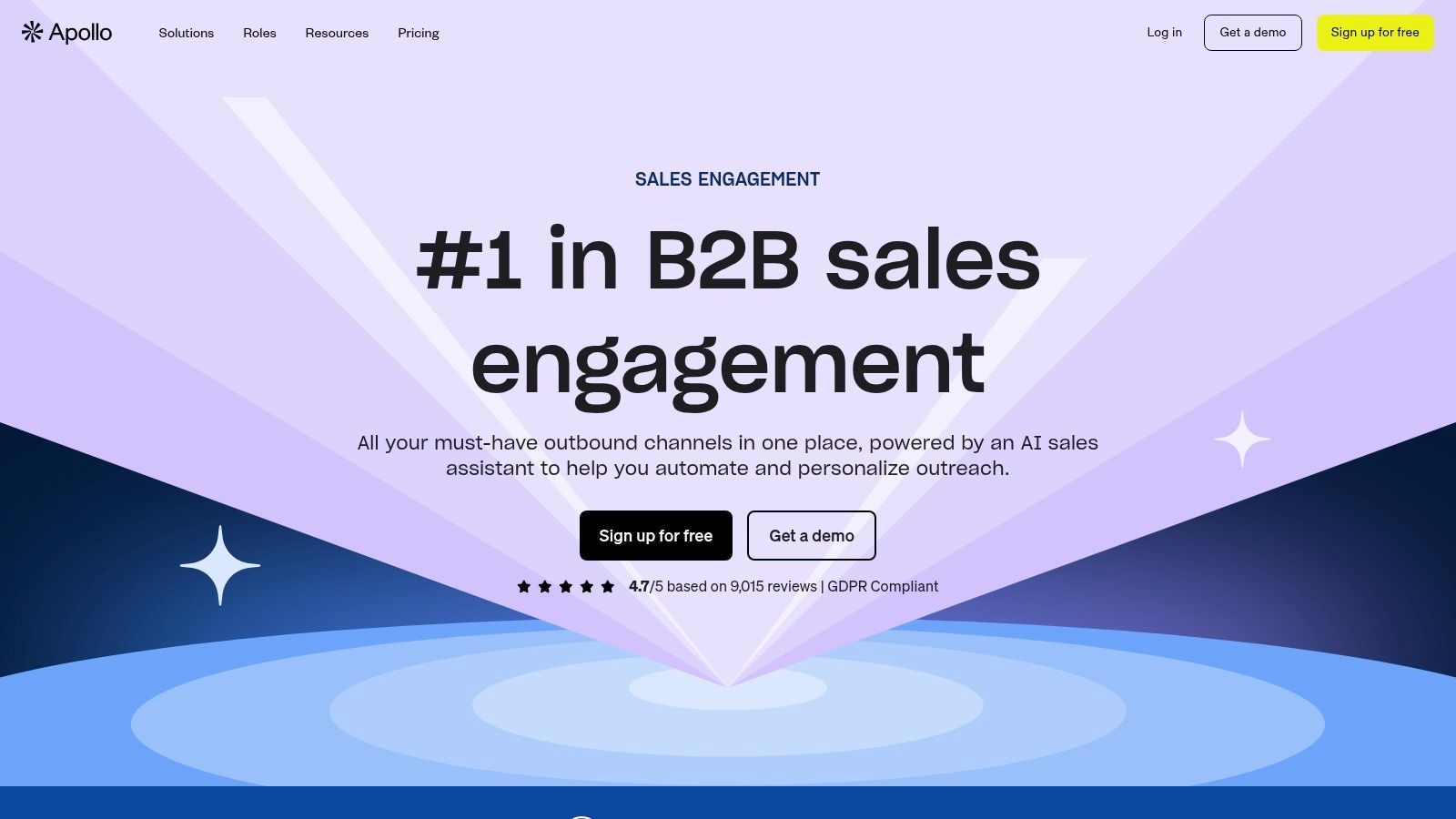
Unlike platforms focused solely on engagement, Apollo's core strength is its integrated data graph, allowing users to find prospects and enroll them in multichannel sequences without leaving the platform. Its generous free tier makes it highly accessible for teams wanting to test its functionality before committing. However, the credit-based system for data and advanced features can become complex. For a deeper breakdown of its costs, our guide on if Apollo pricing is worth the investment provides more detail.
Key Features & Use Cases
- Integrated B2B Database: Access a database of over 275 million contacts for lead generation and data enrichment.
- Multichannel Sequences: Build and automate outreach campaigns across email, phone calls, and LinkedIn tasks.
- AI-Assisted Writing: Use AI to generate personalized emails and improve messaging relevance at scale.
- Deliverability Suite: Includes features like an email warm-up tool and deliverability scoring to maintain sender reputation.
Pros & Cons
- Pro: Excellent value by combining a large contact database with sales engagement tools.
- Pro: A popular and feature-rich free tier allows teams to trial core workflows effectively.
- Con: The credit-based system for data and features can be confusing and lead to unexpected costs.
- Con: Advanced usage and higher data volumes often require upgrading to more expensive tiers or purchasing add-ons.
Who is Apollo.io for?
Apollo.io is ideal for startups, small to mid-sized businesses, and sales teams that need an affordable, integrated solution for both prospecting and outreach. It's a powerful choice for organizations wanting to replace separate data and engagement tools with a single platform. While it offers a broad feature set, teams that require the most advanced AI personalization and deliverability controls might find a specialized platform like PlusVibe better suited to their needs.
6. Clari Groove (formerly Groove)
Clari Groove is a sales engagement platform built specifically for organizations deeply embedded in the Salesforce ecosystem. Acquired by revenue platform Clari, Groove excels at ensuring high data fidelity and providing enterprise-grade governance. It’s a strong SalesLoft alternative for large, complex teams who prioritize seamless CRM integration and administrative control over all other features, making it a go-to for full-cycle sellers operating within a strict Salesforce framework.

Unlike standalone tools that can create data silos, Groove’s native Salesforce architecture ensures that every activity, from emails to calls, is logged accurately and automatically. This eliminates sync errors and provides a single source of truth for revenue operations. Its integration into the broader Clari platform also offers a path to connect engagement activities directly with forecasting and revenue intelligence, a major draw for data-driven leadership.
Key Features & Use Cases
- Native Salesforce Integration: Every action is logged in real-time to Salesforce fields, tasks, and objects without API sync delays.
- Multi-Channel Cadences: Build and manage sequences (called Flows) that incorporate emails, calls, LinkedIn steps, and other tasks.
- Automated Activity Capture: Automatically logs all seller activity to the correct Salesforce records, saving time and ensuring data accuracy.
- Governance & Playbooks: Admins can enforce best practices, set role-based permissions, and create standardized playbooks for the entire team.
Pros & Cons
- Pro: Unmatched Salesforce data fidelity and administrative control for enterprise environments.
- Pro: Highly intuitive for reps already working heavily within the Salesforce UI.
- Con: Pricing is quote-based and tailored for enterprise budgets, making it less accessible for smaller teams.
- Con: Its greatest strength is a limitation; its value diminishes significantly for organizations not using Salesforce as their primary CRM.
Who is Clari Groove for?
Clari Groove is the ideal choice for enterprise-level organizations that live and breathe Salesforce and require a highly governed, secure sales engagement solution. It’s perfect for global teams needing to standardize processes and maintain pristine CRM data. However, for teams whose top priorities are advanced AI personalization and maximizing email deliverability across various CRMs, a more specialized platform like PlusVibe will provide more focused and powerful capabilities.
7. Mixmax
Mixmax is a sales engagement platform built directly into your Gmail inbox, making it a highly accessible and user-friendly alternative to SalesLoft. It focuses on streamlining workflows for individuals and teams who live in their email client, offering powerful enhancements like one-click meeting scheduling, email tracking, and sequencing without ever leaving Gmail. This in-inbox approach significantly reduces context switching and boosts rep productivity for faster execution.
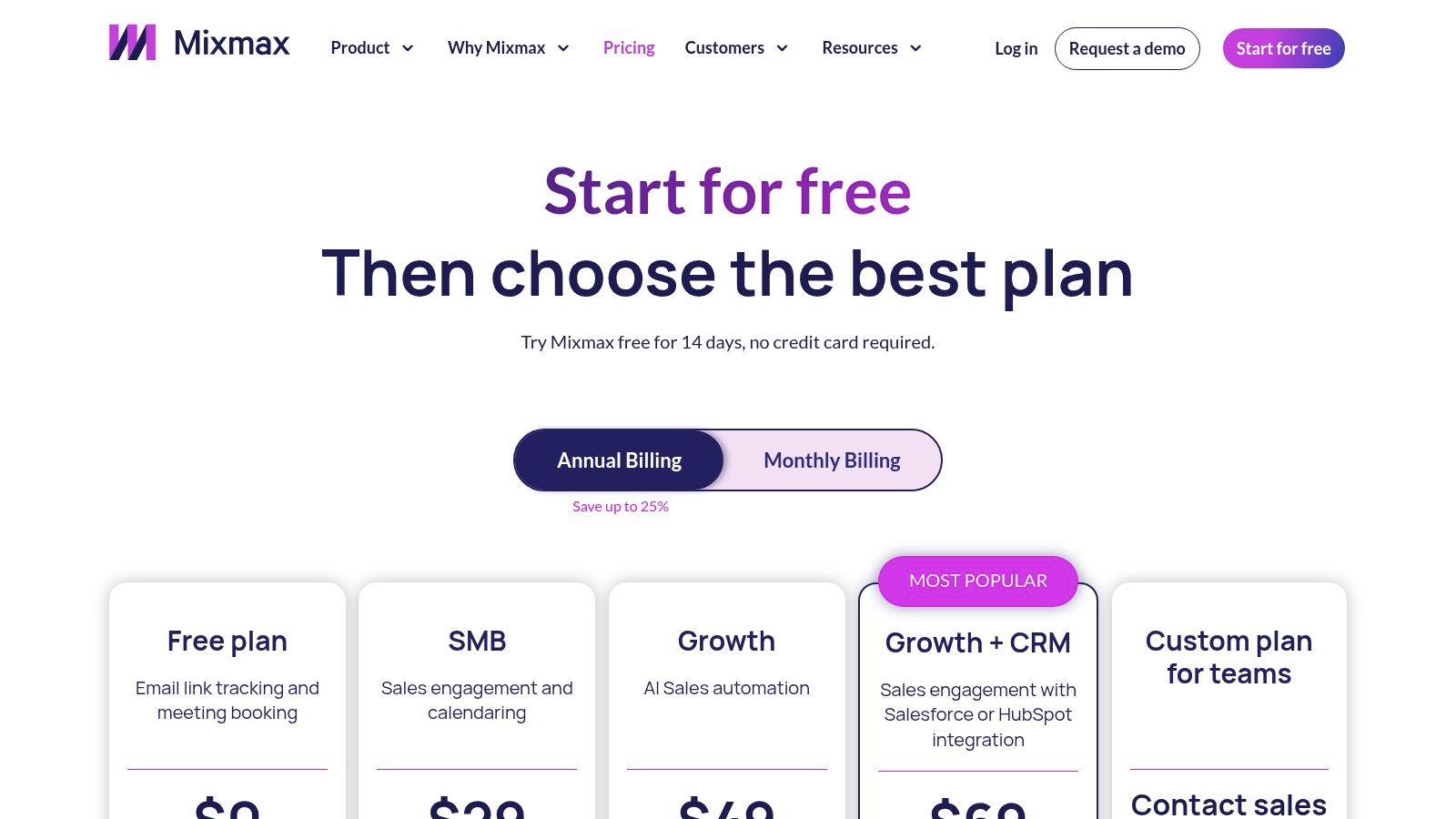
Unlike standalone platforms, Mixmax enriches the existing email experience with sales-focused tools. Its robust calendaring and polling features are standout capabilities, making it incredibly easy to book meetings. For teams prioritizing speed, ease of use, and high adoption within a Gmail-centric workflow, Mixmax offers a compelling package. It’s an excellent choice for those who find comprehensive platforms too cumbersome for their daily needs.
Key Features & Use Cases
- In-Gmail Sequences & Templates: Build and launch multi-step, automated email sequences directly from your compose window.
- One-Click Meeting Scheduling: Share availability and embed calendar slots into emails to eliminate back-and-forth scheduling.
- AI-Powered Composition: Utilizes AI to help reps write effective emails faster, right within their workflow.
- Salesforce & HubSpot Integration: Offers deep, bi-directional sync with major CRMs on its higher-tier plans.
Pros & Cons
- Pro: Native Gmail integration leads to high user adoption and minimal training time.
- Pro: Transparent, seat-based pricing with a free trial available for easy evaluation.
- Con: Less ideal for teams using Outlook, as its primary focus and best features are built for Gmail.
- Con: Multichannel capabilities like a dialer and advanced analytics are often locked behind higher-priced plans.
Who is Mixmax for?
Mixmax is best suited for small to mid-sized sales teams and individuals who operate heavily within Gmail and need to enhance their productivity with engagement tools. It's a great fit for organizations that value speed and efficiency in their email outreach and meeting booking processes. However, teams requiring advanced AI personalization and sophisticated email deliverability controls might find a specialized tool like PlusVibe to be a more powerful solution.
8. Reply.io
Reply.io is a multichannel sales engagement platform that stands out for its flexibility and strong focus on deliverability. It serves teams looking for a comprehensive yet adaptable alternative to SalesLoft, offering outreach capabilities across email, calls, SMS, LinkedIn, and even WhatsApp. This makes it a great fit for businesses that want to orchestrate complex, multi-touchpoint campaigns without being locked into a rigid, all-or-nothing system.
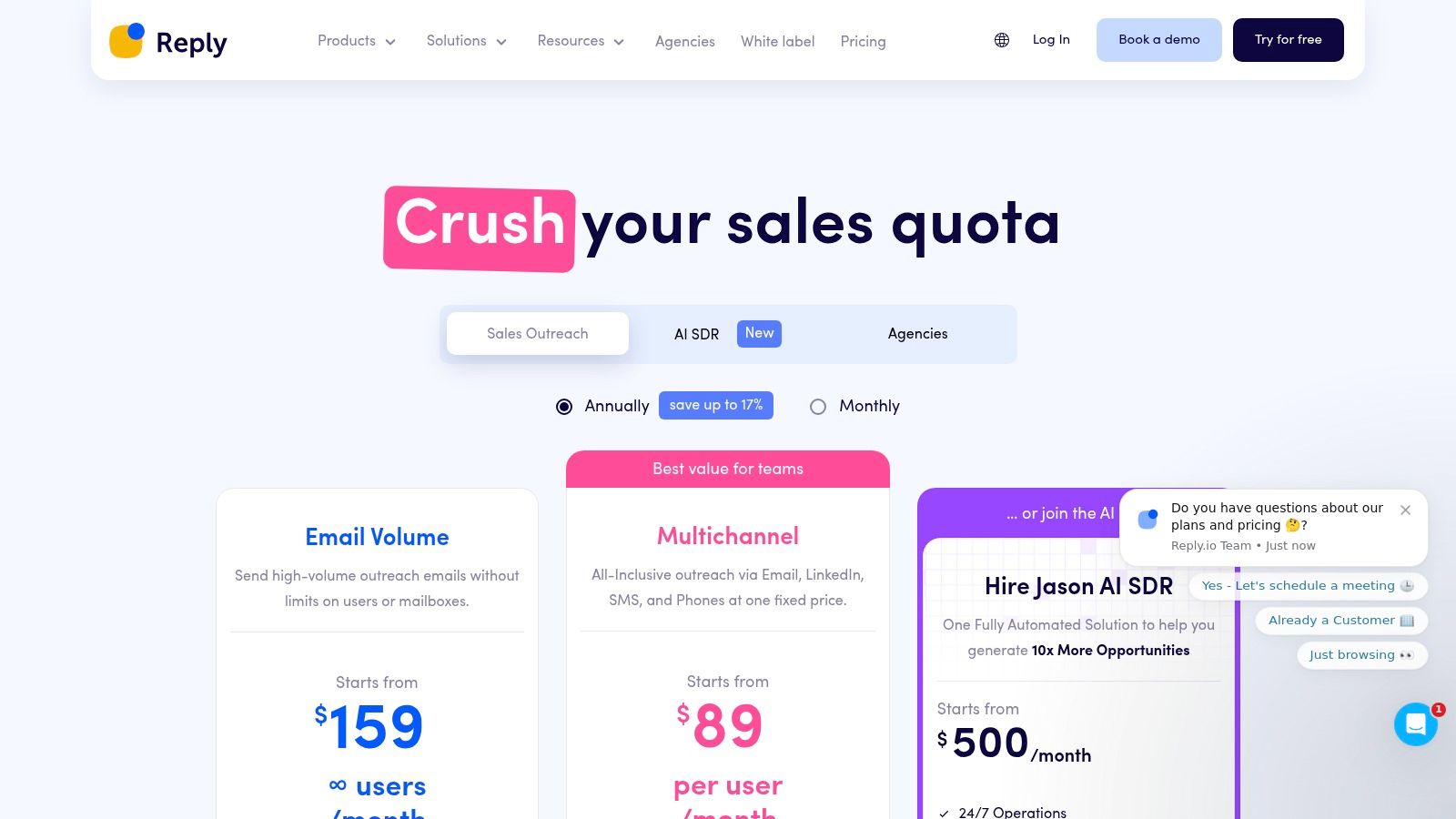
Unlike many competitors where deliverability tools are an expensive add-on, Reply.io includes a built-in email warm-up and deliverability suite in its core plans. Its pricing model is also notably flexible, with plans based on contact volume or all-inclusive packages. A unique offering is its "AI SDR" service, which can automate prospecting and initial replies, appealing to teams aiming to scale their top-of-funnel activities efficiently.
Key Features & Use Cases
- Multichannel Sequences: Engage prospects across email, LinkedIn, calls, SMS, and WhatsApp within a single automated cadence.
- Built-in Deliverability Suite: Includes email warm-up and health checks to ensure messages land in the primary inbox.
- Jason AI: An AI sales assistant that helps write sequences, handle prospect responses, and book meetings.
- Flexible Add-ons: Dialer, SMS, and advanced LinkedIn automation can be added based on specific team needs.
Pros & Cons
- Pro: Includes powerful deliverability and email warm-up tools as part of its standard offering.
- Pro: Flexible pricing plans cater to different team sizes and outreach volume requirements.
- Con: Key channels like calling and LinkedIn automation are often priced as separate add-ons.
- Con: The user interface has a learning curve due to the depth and breadth of its features.
Who is Reply.io for?
Reply.io is best for sales teams at SMBs and mid-market companies that need a versatile, multichannel outreach tool with a strong emphasis on email deliverability. It's an excellent choice for organizations that value flexible pricing and the ability to add functionalities as they scale. While Reply.io offers a robust feature set, teams seeking even more advanced AI-driven personalization and integrated data enrichment might find a platform like PlusVibe.ai to be a more specialized solution for maximizing reply rates.
9. Yesware
Yesware is a lightweight and budget-friendly sales engagement tool that operates directly inside Gmail and Outlook. As a streamlined alternative to SalesLoft, it focuses on core email-centric functionalities, making it an ideal choice for small businesses, startups, and sales teams that want to enhance their inbox capabilities without adopting a complex, standalone platform. Its primary goal is to add essential tracking, automation, and scheduling features to the user's existing email client.
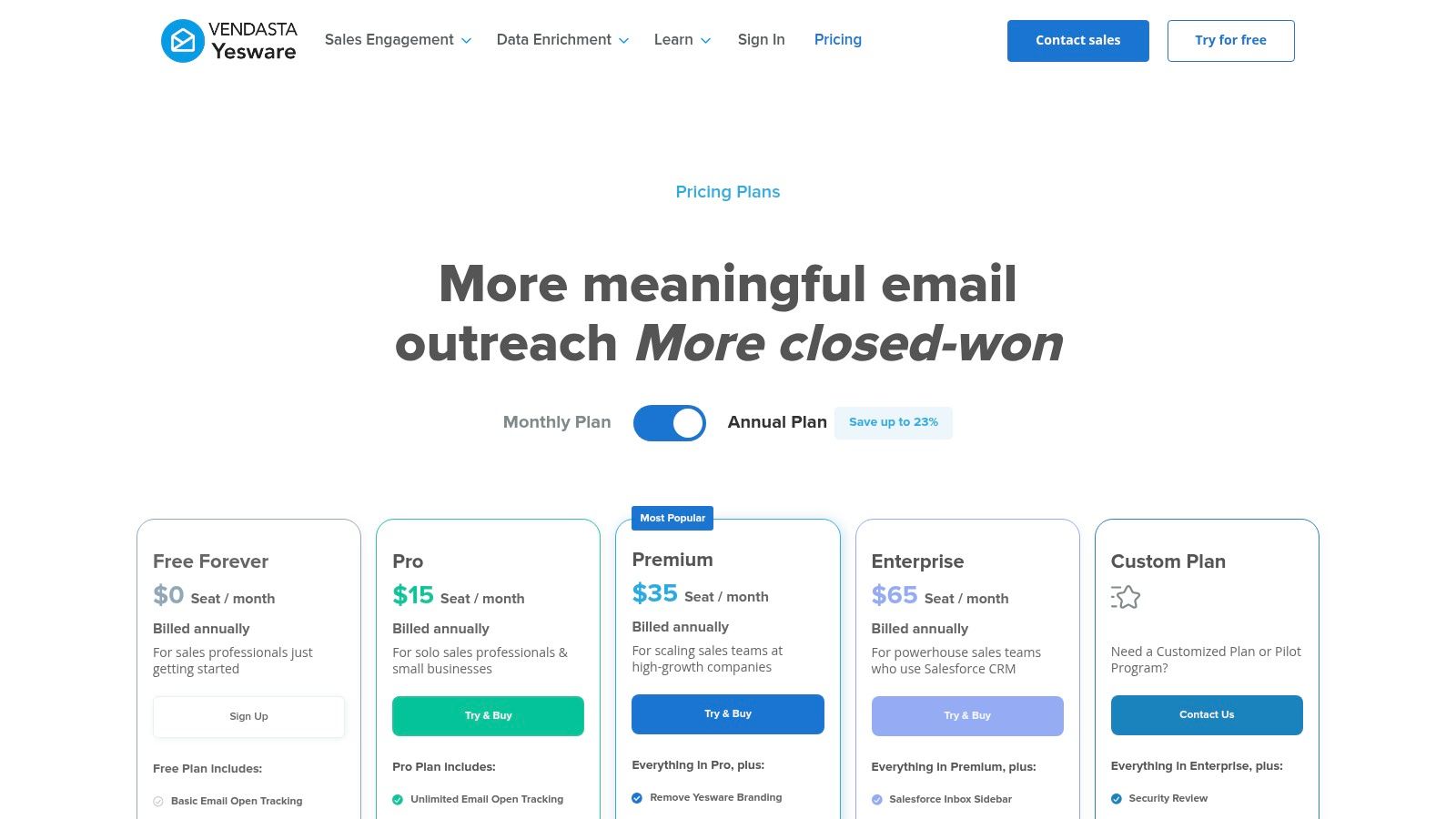
Unlike comprehensive platforms, Yesware prioritizes simplicity and ease of use. It allows reps to track email opens and link clicks, use templates, and run basic multi-touch email campaigns directly from their inbox. This minimal learning curve allows teams to get started quickly and see immediate productivity gains. For teams whose outreach is predominantly email-based and who don't require advanced multichannel sequencing or AI features, Yesware offers a practical and affordable solution.
Key Features & Use Cases
- Email Tracking: Provides real-time notifications for email opens, link clicks, and attachment views.
- Campaigns and Templates: Allows users to build simple, automated email sequences and save high-performing templates.
- Meeting Scheduler: Simplifies appointment setting by allowing prospects to book directly on a user's calendar.
- Salesforce Sync: Offers bi-directional synchronization with Salesforce to log activities automatically (available on higher-tier plans).
Pros & Cons
- Pro: Extremely easy to install and use as a Chrome or Outlook add-in, requiring minimal training.
- Pro: Offers transparent and affordable pricing tiers, including a free plan for basic needs.
- Con: Lacks advanced multichannel features like a native dialer or social media touchpoints.
- Con: Primarily focused on email outreach, making it less suitable for complex sales motions.
Who is Yesware for?
Yesware is best suited for individuals and small to mid-sized sales teams that live in their inbox and need a simple, effective tool to track engagement and automate follow-ups. It's an excellent entry-point for organizations new to sales engagement. However, teams looking for sophisticated AI-driven personalization, advanced deliverability controls, and true multichannel capabilities would find a platform like PlusVibe to be a more scalable and powerful solution.
10. Mailshake
Mailshake is a streamlined, cold-email-first engagement platform designed for sales development teams, agencies, and small businesses focused on direct outbound prospecting. While simpler than enterprise-level systems, it excels at core outreach tasks like automated email sequencing, list management, and performance tracking. Its value proposition is amplified by multichannel add-ons, including a power dialer and LinkedIn automation, making it a powerful yet accessible alternative to SalesLoft for teams that prioritize simplicity and cost-effectiveness.
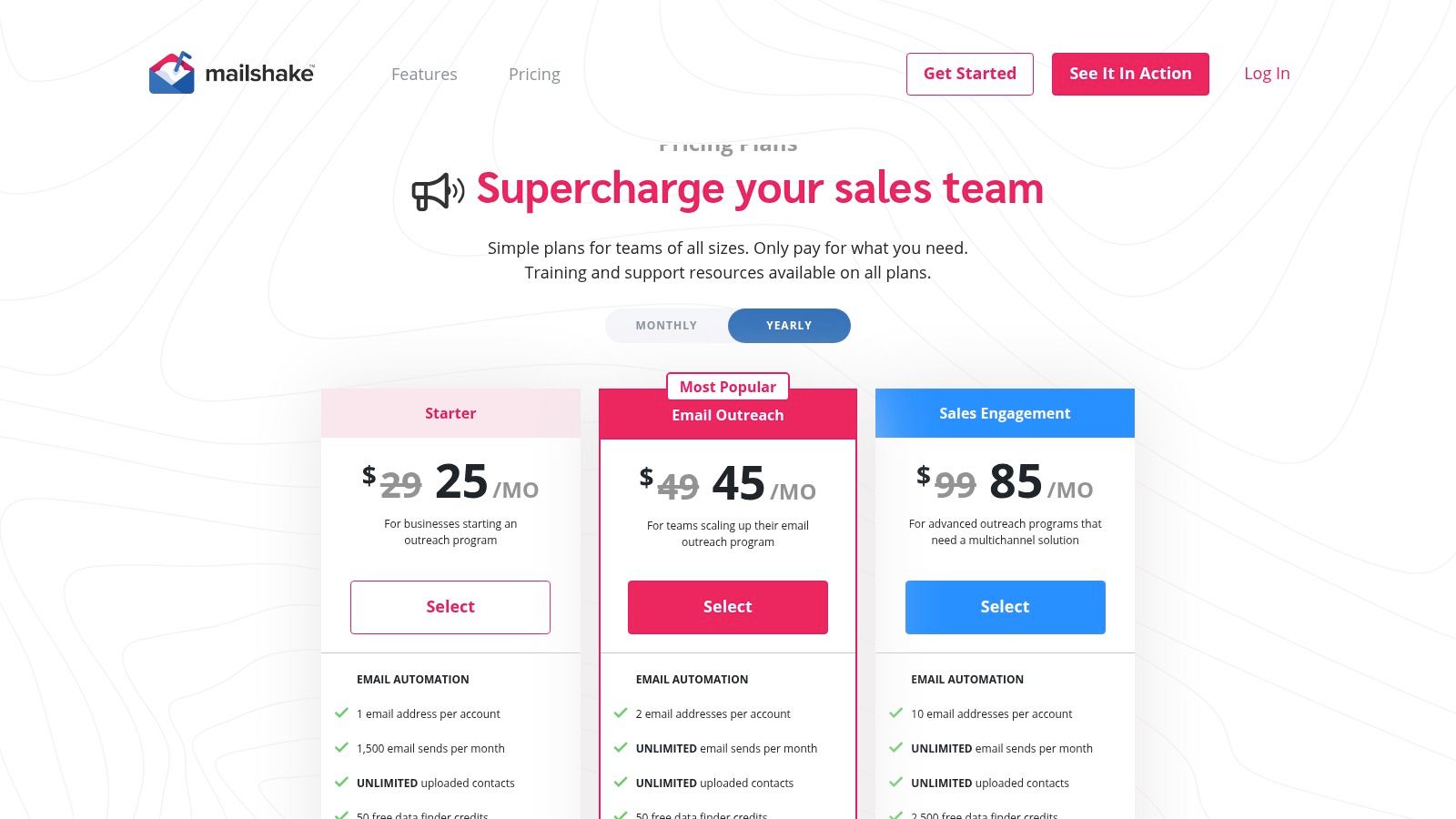
Unlike comprehensive platforms that manage the entire sales cycle, Mailshake focuses on the top-of-funnel activities crucial for generating new leads. Its straightforward interface allows users to launch A/B tested campaigns quickly, while features like the Data Finder help enrich contact lists directly within the platform. The inclusion of unlimited North America calling on its Sales Engagement plan offers exceptional value for teams heavily reliant on phone outreach in that region.
Key Features & Use Cases
- Automated Email Sequences: Build and manage multi-touch email campaigns with personalization tags, A/B testing, and automated follow-ups.
- Built-in Power Dialer: Features a native VoIP phone and dialer, with unlimited minutes for North American numbers on the top-tier plan.
- LinkedIn Automation: A Chrome extension enables automated profile visits, connection requests, and messages as steps within a sequence.
- Data Finder & List Cleaning: Provides tools to find email addresses for contacts and verify lists to improve deliverability.
Pros & Cons
- Pro: Straightforward pricing and unlimited sending on higher tiers offer predictable costs.
- Pro: Strong value proposition for US/Canada-based teams due to the unlimited dialer minutes.
- Con: Lacks the deep CRM integration, deal management, and forecasting tools found in SalesLoft.
- Con: The most powerful features are gated on the highest Sales Engagement plan, and paid onboarding is required.
Who is Mailshake for?
Mailshake is an excellent fit for small to mid-sized SDR teams, lead generation agencies, and founders who need an efficient tool for top-of-funnel outreach without the complexity of an enterprise platform. It's ideal for organizations that want to combine email, phone, and social selling in a single, easy-to-use interface. For teams needing more advanced AI personalization and deliverability controls, a platform like PlusVibe.ai might offer a more robust and scalable solution.
11. Klenty
Klenty is a sales engagement platform that positions itself as a strong, well-priced alternative to SalesLoft, particularly for small to mid-market teams. It provides a robust multichannel outreach system, including email, calls, SMS, and LinkedIn tasks, all managed through its cadence builder. Its standout feature is the deep, bi-directional sync with popular CRMs, which ensures sales reps work with up-to-date information without leaving their primary workflow.
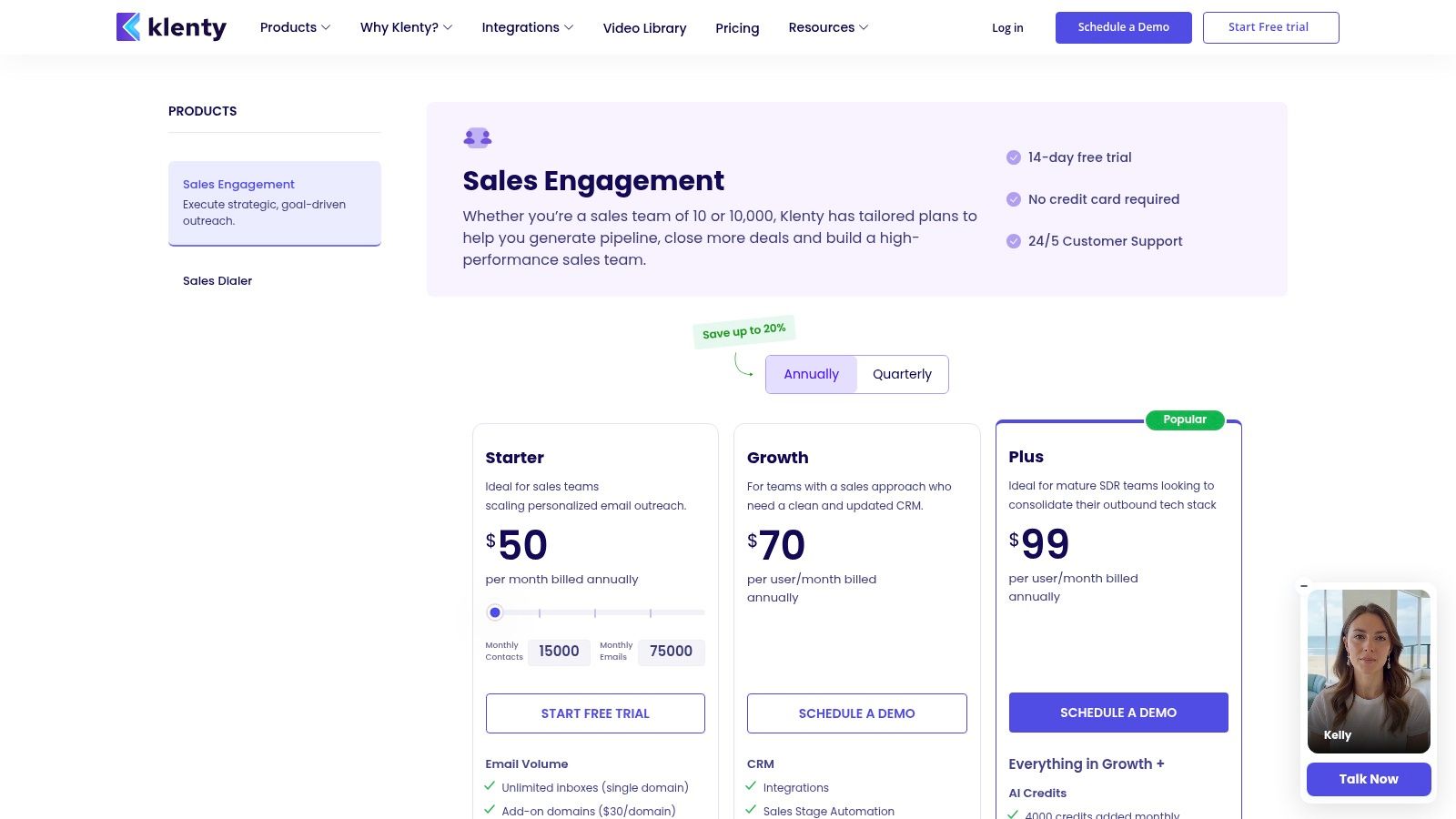
Unlike enterprise-focused platforms, Klenty prioritizes ease of use and transparent pricing, making it accessible for growing teams that need powerful automation without a complex implementation. The platform also offers goal-based coaching and performance insights, allowing managers to track team milestones and rep productivity effectively. This focus on CRM integration and straightforward multichannel sequencing makes it a practical choice for teams scaling their outreach efforts.
Key Features & Use Cases
- Multichannel Cadences & Dialer: Execute sequences across email, calls (with parallel/power dialer options), SMS, and LinkedIn.
- AI List Building & Enrichment: Use AI credits to build prospect lists and enrich existing contact data directly within the platform.
- Deep CRM Integration: Offers seamless, bi-directional sync with CRMs like HubSpot, Salesforce, and Pipedrive to automate stage changes.
- Goals & Performance Insights: Set team goals, track milestones, and analyze rep performance with detailed dashboards.
Pros & Cons
- Pro: Transparent pricing and generous email volumes make it a cost-effective option for SMBs.
- Pro: Add-on modules for the dialer and conversation intelligence allow teams to extend capabilities as they grow.
- Con: Some advanced AI features and higher dialer minute allowances are limited to more expensive tiers.
- Con: Feature sets and availability can vary between plans, requiring careful review before purchasing.
Who is Klenty for?
Klenty is best suited for SMB and mid-market sales teams seeking a feature-rich yet affordable sales engagement platform. It's an excellent choice for organizations that rely heavily on their CRM and need a tool that offers deep, reliable integration for automating workflows. While Klenty provides strong sequencing capabilities, teams requiring advanced AI-driven personalization and comprehensive email deliverability controls might find PlusVibe's specialized toolset a more targeted solution.
12. lemlist
lemlist is a popular multichannel outreach platform designed for outbound sales and marketing teams who value creativity and strong email deliverability. It stands out from more traditional SalesLoft alternatives by bundling features like email warm-up, a verified lead database, and flexible sequencing that includes email, LinkedIn, and call steps. This makes it an attractive option for teams that need an all-in-one tool for building and executing campaigns from scratch.
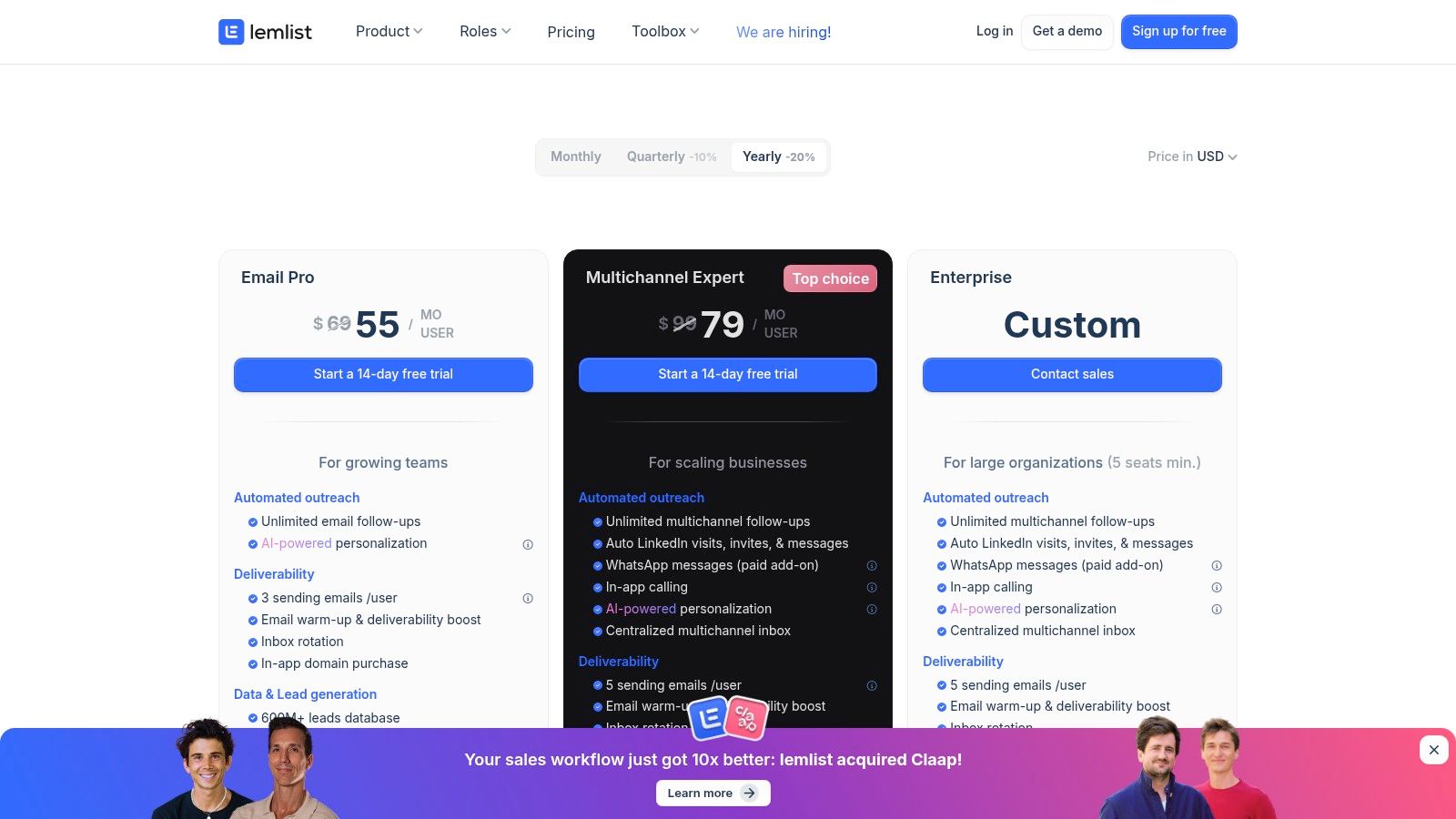
Unlike enterprise-focused platforms, lemlist emphasizes deliverability with its "lemwarm" feature to keep sending domains healthy. Its user-friendly interface simplifies the process of creating personalized campaigns with dynamic images and videos, fostering a more hands-on approach to outreach. For a deeper look, you can explore our detailed comparison of lemlist and its alternatives. While lemlist is a strong contender, teams often look for alternatives. You might also consider exploring an alternative to lemlist that aligns with specific workflow or budget requirements.
Key Features & Use Cases
- Multichannel Sequences: Build outreach flows that combine automated emails, LinkedIn profile visits, connection requests, and manual call steps.
- Email Warm-Up & Deliverability Tools: Includes lemwarm to automatically warm up email accounts and improve sender reputation.
- Built-in Lead Database: Access a B2B lead database with verified contacts and enrichment credits included in monthly plans.
- Personalization Features: Create highly personalized messages using custom variables, conditional logic, and dynamic image or video landing pages.
Pros & Cons
- Pro: All-in-one platform with built-in email warming and lead sourcing, reducing the need for extra tools.
- Pro: Flexible and transparent pricing with monthly options available, making it accessible for smaller teams.
- Con: Can become expensive as you scale users and require more advanced features.
- Con: The user interface, while modern, can feel complex for users new to multichannel sequencing.
Who is lemlist for?
lemlist is best for small to mid-sized sales teams, marketing agencies, and founders who manage their own outbound campaigns. It's an excellent choice for those prioritizing email deliverability and creative personalization in their outreach efforts. However, teams requiring more advanced AI-driven personalization and scalability may find PlusVibe's dedicated platform better suited to their needs.
Salesloft Alternatives — Top 12 Comparison
Choosing the Right SalesLoft Alternative for Your Team
Navigating the landscape of sales engagement platforms can feel overwhelming, but making an informed decision is crucial for your team's success. The core takeaway from our deep dive into the top SalesLoft alternatives is that there is no single "best" platform for everyone. The ideal choice hinges entirely on your organization's unique context, strategic goals, and operational workflows.
SalesLoft set a high standard for multichannel sequencing and sales process automation. However, as we've seen, the market has evolved, producing a diverse ecosystem of specialized tools designed to solve specific challenges more effectively. Your task is to move beyond a simple feature-for-feature comparison and diagnose the root cause of your team's biggest growth obstacles.
Key Decision Factors Revisited
Before making a final choice, revisit these critical evaluation points with your team. A clear understanding of your priorities will illuminate the right path forward.
- Primary Use Case: Are you focused on enterprise-level account-based selling, high-volume SMB outreach, or a hybrid model? A platform like Outreach is built for complex, multi-stakeholder deals, while tools like Mailshake and lemlist are tailored for targeted, high-volume cold email campaigns.
- CRM Integration: How deeply do you need your sales engagement tool to integrate with your CRM? Teams heavily invested in Salesforce might find native solutions like Salesforce Sales Engagement or tightly integrated platforms like Clari Groove offer the most seamless experience. Conversely, if your CRM is HubSpot, Sales Hub is the obvious front-runner.
- Technical Overhead: Consider your team's technical aptitude. All-in-one platforms like Apollo.io and HubSpot offer convenience but can be complex to master. More focused tools like PlusVibe prioritize a streamlined user experience, allowing teams to get up and running with advanced features without a steep learning curve.
- Budget and Scalability: Your budget is a primary constraint, but it's equally important to consider future growth. A tool that seems affordable today may become prohibitively expensive as your team scales. Evaluate the total cost of ownership, including per-seat licenses, add-ons, and potential implementation fees.
Making the Strategic Choice
For large enterprise teams already embedded in the Salesforce ecosystem, Outreach and Clari Groove remain formidable contenders, offering robust analytics and deep CRM synchronization. SMBs looking for a consolidated GTM platform will find significant value in the all-in-one capabilities of HubSpot Sales Hub or Apollo.io, which combine sales engagement with lead data and marketing automation.
However, for a growing segment of sales teams, the most critical challenge isn't just automating outreach; it's ensuring that outreach actually lands in the primary inbox and resonates with the recipient. This is where a modern, specialized platform like PlusVibe truly differentiates itself. By focusing intently on deliverability infrastructure (email warming, validation, and advanced sending controls) and AI-powered personalization, PlusVibe directly addresses the core reasons why many sales campaigns fail. It’s built for teams that understand that sequence volume is a vanity metric if your emails are landing in spam or being ignored.
Ultimately, the best SalesLoft alternative is the one that empowers your team to not just do more, but to do better. It's the platform that aligns with your sales motion, integrates with your existing tech stack, and provides the specific tools you need to overcome your most significant revenue bottlenecks. Use this guide as your framework, shortlist your top two or three contenders, and run dedicated trials with a pilot group. The firsthand experience of your reps is the most valuable data you can collect. Choose the partner that will help you build more meaningful connections and drive predictable growth.
Ready to see how advanced deliverability and AI can transform your outreach results? Discover why forward-thinking sales teams are choosing PlusVibe as their preferred SalesLoft alternative. Start your free trial today and experience the power of getting your message into the right inbox, every time.














































.jpeg)


.png)























































